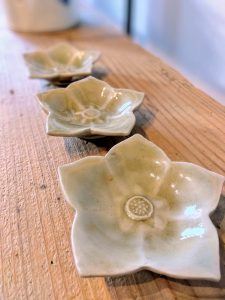おばあちゃんの方言は可愛らしく聞こえます(愛知県名古屋市千種区姫池通 骨董買取 古美術風光舎)
2024.12.01
そんなこんなで、今日から12月師走です。毎年のことながら、時の早さに驚いております。
僧侶も走ると言われるほど慌ただしい12月ですが、終わりよければ…の気持ちであと1カ月乗り切りたいと思います。
さて、私、普段は標準語を話しているつもりですが、地元に帰ると途端に言葉がうつってしまいます。今日は自分ではあまり誇れるところはないと思っている名古屋弁についてのつぶやきですが、どうぞおつきあいください。

先日実家に立ち寄った時のご近所のおばあちゃんに話しかけられました。
「柿がよーいろんどるで、うみゃーわ。一つあーますで食べてみやあ」
「庭にまんだよーけなっとるで、持って帰えりゃ~」
90歳近いおばあちゃんのなかなかにキツイ名古屋弁ですが、こうして文字に起こすと、意味不明です(笑)
訳すと「柿がよく熟していて美味しいよ。一つあげるから食べてみて」「庭にまだたくさんなっているから、持って帰ってね」という内容になります。
「いろむ」は名古屋弁で果実などが色づき熟すことを言いますが、色は関係なく、赤い柿でも実が固ければ「まだいろんどらん」となります。
あの有名な方のおかげか、名古屋人はあのような名古屋弁を話すと思われているかもしれませんが、あれほどの名古屋弁を話す人はもう少ないと思います。聞けば翻訳はできますけどね。
とはいえ、自分でも気づかない日常に溶け込んだ方言を使っている場合もあります。
「○○を持ってみえる」などの「みえる」も方言だし、「あの角を右にまわって」の「まわる」も標準語では「曲がる」です。机を二人で持つときの「つる」が全く通じないと知った時は驚きました。
方言には言葉そのものだけでなく、発音もありますが、名古屋弁の「黄」の発音。
名古屋人にはついうっかり「きぃ」と発音してしまう人もいます。正しく「き」と言うのは「黄色」とか「黄色い」と続くときぐらいで、その「黄色い」も年配の方になると「きいない」、ちょっとくだけると「きーにゃー」となります。すごく黄色い場合は、「まっきっき」とか「まっきいきい」と言ったりします。
子どもの頃よく母にいわれました。「(信号が)きいになるで、気ぃつけやーよ」と。
他に認知度の高い名古屋弁でいえば「でら」でしょうか。
「えらい」これに強調の「ど」が付くと「どえらい」になり、名古屋弁ではさらにオーバーに「でえーりゃー」と発音され、「でら」に略されて使われるのです。
この「えらい」には「苦しい」とか「つらい」「疲れた」とかいった意味があります。大阪弁で言う「しんどい」に当たるもので、「どえらいえらい」と言われてそんなに立派な人間なのかと思ったら大間違い、「非常に苦しい」とか「大変疲れた」と言っているだけなのです。
「でら」を流行語?にしたのは、やはり何と言ってもキリンの売り出した地域限定ビール「でらうま」かなと思います。「でらうま」は名古屋弁の「どえらい(あるいはでえーりゃー)うみゃあ」の略。ラベルに馬のような絵が描かれてはいますが、名古屋人なら「でらうま」を「でっかい馬」あるいは「立派な馬」と思う人はまずいないでしょうね。
ではでは、また。(スタッフT)

And so, today is December, the month of Shihan. Every year, I am surprised at how quickly time flies.
December is so hectic that even monks are said to be running, but I hope to get through one more month with the feeling that all’s well that ends well.
Now, I usually try to speak in standard Japanese, but when I go back to my hometown, I instantly lose my accent. Today, I would like to share with you some of my musings on the Nagoya dialect, which I am not very proud of.
When I stopped by my parents’ house the other day, my neighbor’s grandmother spoke to me.
She said, “Persimmons are very delicious. Try one and eat it.
There are a lot of persimmons in the garden, you can take some home.
This is the rather harsh Nagoya dialect of a nearly 90-year-old grandmother, but when I put it into words like this, it makes no sense at all (laughs).
The translation is, “The persimmons are ripe and delicious. I’ll give you one to try.” ”There are still many in the garden, so please take one home.
Iromu” is a Nagoya dialect word for a fruit that is ripening and turning color, but it does not matter what color it is, even a red persimmon will still be called ‘Irodoran’ if the fruit is hard.
Thanks to that famous person, people may think that Nagoya people speak Nagoya dialect like that, but I think there are not many people who speak Nagoya dialect like that anymore. If you listen to it, though, you can translate it.
Nevertheless, there are cases where people use dialects that have blended into their daily lives that you are not even aware of.
For example, “mieru” in Japanese is also a dialect, as is “mieru” in Japanese, and “mawaru” in Japanese is “kurumagaru” in standard Japanese. I was surprised when I learned that “tsuru,” which is used when two people hold a desk together, is not understood at all.
Dialects include not only the words themselves, but also the pronunciation of the word “yellow” in the Nagoya dialect.
Some Nagoya people inadvertently pronounce it “kii”. The correct pronunciation of “kii” is only when followed by “kiiroi” or “yellow.” For older people, “kiiroi” is “kiiinai,” and for those who are a little older, “ki-nya-”. If it is very yellow, it is called “makki-kikki” or “makki-kikki.
When I was a child, my mother used to say to me. She used to say to me when I was a child, “Be careful, the signal is going to be yellow.
Another well-known Nagoya dialect word is “dera.
In the Nagoya dialect, it is pronounced “de-ee-rya-” and abbreviated to “dera” (dera).
The word “erai” has the meaning of “suffering,” “hard,” or “tired. It is equivalent to “shindoi” in Osaka dialect. If you think you are such a great person when you are called “doe-erai-erai,” you are mistaken.
What made “dera” famous, after all, was “dera-uma,” a regional beer marketed by Kirin. Derama” is an abbreviation of ‘Doerai (or Deerai-rya) Umiaa’ in the Nagoya dialect. Although there is a picture of a horse on the label, I doubt that most Nagoya people would think of “de lauma” as a “big horse” or a “splendid horse.
See you soon.
*******************
ご実家の整理やお片付けなどをされている方のご相談などが多くございます。
お片付けなどくれぐれもご無理のないようになさってくださいませ。
風光舎では古美術品や骨董品の他にも絵画や宝石、趣味のお品など様々なジャンルのものを買受しております。
お片付けをされていて、こういうものでもいいのかしらと迷われているものでも、どうぞお気軽にご相談下さいませ。
また風光舎は、出張買取も強化しております。ご近所はもちろん、愛知県内、岐阜県、三重県その他の県へも出張いたします。
まずは、お電話お待ちしております。
愛知県名古屋市千種区姫池通
骨董 買取【古美術 風光舎 名古屋店】
TEL052(734)8444
10:00-18:00 OPEN
#出張買取#骨董#古美術#骨董品#絵画#版画#茶道具#刀剣#彫刻

